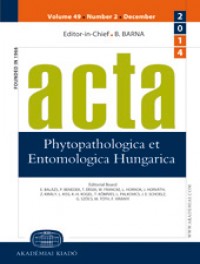Acta Phytopathologica et Entomologica Hungarica Q4 Unclaimed
Acta Phytopathologica et Entomologica Hungarica is a journal indexed in SJR in Plant Science and Insect Science with an H index of 25. It has a price of 900 €. It has an SJR impact factor of 0,188 and it has a best quartile of Q4. It is published in English. It has an SJR impact factor of 0,188.
Type: Journal
Type of Copyright:
Languages: English
Open Access Policy:
Type of publications:
Publication frecuency: -

900 €
Inmediate OANPD
Embargoed OA0 €
Non OAMetrics
0,188
SJR Impact factor25
H Index8
Total Docs (Last Year)47
Total Docs (3 years)424
Total Refs20
Total Cites (3 years)47
Citable Docs (3 years)0.45
Cites/Doc (2 years)53.0
Ref/DocOther journals with similar parameters
Phytocoenologia Q4
Journal of the Botanical Research Institute of Texas Q4
Feddes Repertorium Q4
Russian Journal of Theriology Q4
Journal of the International Society for Southeast Asian Agricultural Sciences Q4
Compare this journals
Aims and Scope
Best articles by citations
Exotic mite family (Parholaspididae Evans, 1956) introduced to Hungary: First record of Holaspina alstoni (Evans, 1956) from Hungarian greenhouses (Acari: Mesostigmata)
View moreEmergence of new virulence inPlasmopara halstedii(sunflower downy mildew)
View moreNew host records of parasitoids of scale insects and whitefly species in Egypt
View moreEvaluation of petroleum based horticulture oil for the management of the tea red spider mite,Oligonychus coffeaeNeitner (Acarina: Tetranychidae)
View moreLeaf Beetles (Coleoptera: Chrysomelidae) of Tehran, Alborz and Qazvin Provinces, Iran
View moreAddition of Synthetic Feeding Attractant Increases Catches ofRhagoletis batavaHering andCarpomyia schineriLoew. in Fluorescent Yellow Sticky Traps
View morePlant Parasitic Nematodes Associated with Olive in Algeria
View moreDefense related enzyme induction in coconut by endophytic bacteria (EPC 5)
View moreCosmolaelaps keni a polyphagous predatory mite on various insect and mite species (Acari: Laelapidae)
View moreManagement ofMeloidogyne incognitaandMacrophomina phaseolinaby Graphene Oxide onLens culinaris
View moreIdentification of antagonistic bacteria isolated from Thai fermented soybean (Thua Nao) for biocontrol of Lasiodiplodia theobromae
View moreFirst record of the family Penthaleidae (Acari) in Hungary: Morphological and Molecular approaches of the Hungarian Penthaleus cf. major (Duges, 1837)
View moreComparative pathogenicity ofColletotrichumspp. against different varieties of strawberry plants (Fragaria ananassa) widely grown in Morocco
View moreBrachycaudusspecies on herbaceous plants along highways in Hungary
View moreBacterial diseases of wheat caused by Xanthomonas sp. in the Southern Ural: Identification issues
View moreEffect of the Number of Years of Soil Exploitation by Saffron Cultivation in Morocco on the Diversity of Endomycorrhizal Fungi
View moreBacterial Diseases of Wheat in the Southern Ural: Manifestations, Biological Characteristics and Monitoring Features
View moreFamily Signiphoridae (Chalcidoidea) in Egypt
View moreMolecular Detection of Grape Decline Phytoplasma in Leafhopper Species Associated with Infected Grapevines in Iran
View moreAggressiveness variation among and within Fusarium head blight species on barley in vitro
View moreCanPlResistance Gene in Sunflower Line D4 be Used to Differentiate the Pathogenicity in FourPlasmopara halstedii(Sunflower Downy Mildew) Races 304, 314, 704 and 714?
View moreSupplementary description of Aculus scutellariae (Canestrini et Massalongo, 1895) (Acariformes: Eriophyoidea) from Hungary
View moreEfficiency of some medicinal plant extracts and an entomopathogenic fungus, Metarhizium anisopliae separately and in combination with proteus® against the large cabbage butterfly, pieris brassicae L.
View moreEfficacy of wild medicinal plant extracts against predominant seed-borne fungi of broad bean cultivars
View more
Comments